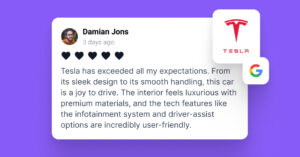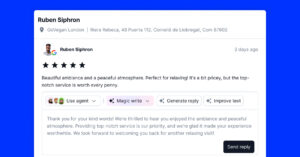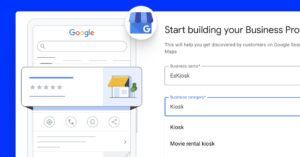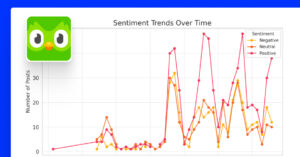Les entreprises s'éloignent de la collecte de données de tiers. Google a déclaré que les cookies tiers ne seront plus utilisés dans Chrome d'ici à la fin de 2023, rejoignant ainsi une liste croissante de navigateurs qui ont abandonné la fameuse technique de suivi permettant de collecter les données en ligne des utilisateurs.
Pour cette raison et en raison des préoccupations croissantes en matière de protection de la vie privée, les données de première main deviennent de plus en plus pertinentes. Les entreprises peuvent se conformer plus facilement aux règles en collectant leurs propres données. Les utilisateurs acceptent souvent que leurs données soient traitées lorsqu'ils achètent auprès de votre organisation et deviennent de véritables clients. Et surtout lorsqu'ils deviennent des clients fidèles, il est beaucoup plus facile pour eux de partager leurs données avec vous. commentaires des clients de manière proactive.
Les données de première partie sont également nécessaires aux entreprises pour offrir une expérience personnalisée à leurs consommateurs. L'audience de première partie peut être ciblée en fonction de données démographiques, d'intérêts et d'intentions d'achat.
En outre, la possession de données de première partie peut éliminer la nécessité de collecter d'autres types de données. Dans cet article, nous allons voir pourquoi les données de première partie sont un outil essentiel pour tout spécialiste du marketing qui souhaite gérer avec succès la relation client dans un paysage technologique en évolution rapide et hautement concurrentiel.
Qu'est-ce qu'une donnée de première main ?
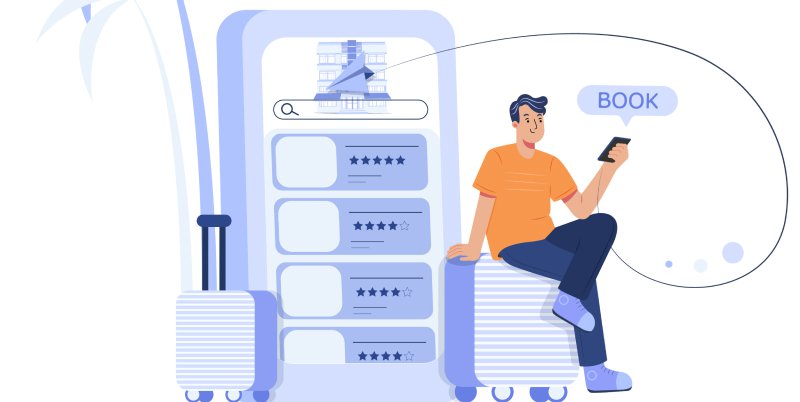
Les données qu'une entreprise collecte directement auprès des utilisateurs sont appelées données de première partie (données 1P).
Ces données peuvent être recueillies par une combinaison de points de données en ligne et hors ligne, tels que les applications mobiles, les sites web, les médias sociaux et les sites internet. questionnaires.
Votre entreprise est propriétaire de ces données et, si les clients ont correctement accepté de les traiter, elle peut les utiliser pour développer du contenu, des publicités et des expériences personnalisées.
Les données de première main peuvent permettre aux spécialistes du marketing de compléter les données et de combler les lacunes des profils d'utilisateurs. Les organisations peuvent créer des groupes d'utilisateurs et proposer des publicités personnalisées aux visiteurs qui quittent leur site web.
Il s'agit d'un outil solide pour rassembler commentaires des clients et des informations sur l'audience afin d'améliorer les efforts de marketing grâce à une expérience personnalisée.
En d'autres termes, les spécialistes du marketing recueillent des données de première main pour mieux connaître leurs utilisateurs. Contrairement aux données collectées à l'aide d'outils externes, qui peuvent souvent être peu fiables, les données de première main sont plus précieuses car le contact entre l'entreprise et l'utilisateur se fait sans médiateur.
Par exemple, vous obtenez des données de première partie en surveillant le comportement de vos utilisateurs dans l'application. Vous pouvez également envoyer des enquêtes auxquelles vos clients répondent directement, et toutes les informations de l'utilisateur soumises dans l'enquête sont considérées comme des données de première partie.
Enfin, l'une des pratiques les plus courantes en matière de collecte de données est la suivante formulaires web où les marques collectent des informations de contact afin de contrôler le canal de communication avec leurs clients.
Voyons en quoi elles diffèrent des données de second et de tiers pour mieux comprendre les données de premier niveau. Nous examinerons quatre facteurs :
- Source des données
- Fiabilité des données
- Capacité à cibler
- Exemples
Données de première partie et données de seconde partie
- Source des données : Contrairement aux données de première partie, qui proviennent directement des clients, les données de deuxième partie proviennent d'une source fiable. En d'autres termes, il s'agit des données de première partie d'une autre entreprise. Vous pouvez convenir avec cette entreprise d'utiliser ses données si vos publics sont similaires.
- Fiabilité des données : L'entreprise à laquelle vous achetez/obtenez des données les possède probablement dans son CRM ou sa base de données. Elle les a collectées directement auprès de son public, et elles sont donc probablement très fiables.
- Capacité à cibler : Pouvez-vous utiliser ces données pour cibler des publics ? Oui, mais la plupart du temps, pas avec autant de précision que vos données de première partie. En effet, toutes les entreprises ont des cibles différentes et vous ne trouverez probablement pas une autre entreprise qui cible exactement les mêmes personnes que vous.
Exemples: Si vous êtes une société de développement de jeux, vous pouvez obtenir des données auprès d'un éditeur de jeux qui a publié des jeux similaires afin de connaître le comportement du public. De même, si vous développez une application visant à améliorer la santé mentale, vous pouvez collaborer avec des psychologues pour obtenir des données.
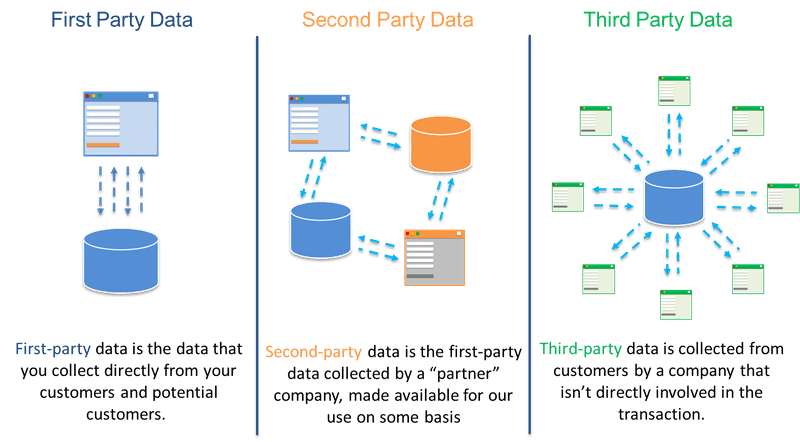
Données de première partie ou de tierce partie
- Source des données : Les données de tiers sont collectées à partir de plusieurs sites web, puis agrégées, catégorisées et vendues à des entreprises à des fins publicitaires.
- Fiabilité des données : Les données provenant d'autres parties sont achetées et vendues de manière programmatique, ce qui implique que cela se produit rapidement et à grande échelle. Dans la plupart des cas, vous n'en connaissez pas la source, et leur fiabilité est donc souvent remise en question.
- Capacité à cibler : Les données de tiers sont disponibles publiquement et de nombreuses entreprises peuvent y accéder. Cela signifie qu'elles ont été créées pour répondre aux besoins de diverses entreprises. Il ne faut donc pas s'attendre à un ciblage précis à l'aide de données tierces.
Exemples : Supposons que vous souhaitiez vendre vos produits aux expatriés britanniques en Allemagne. À cette fin, vous pouvez trouver une société de données en Allemagne qui peut vous vendre les données des personnes de nationalité britannique vivant en Allemagne.
Pourquoi les données de première main sont-elles importantes ?
Ces dernières années, les spécialistes du marketing ont régulièrement dépensé de l'argent pour obtenir des données de tiers. Cependant, beaucoup se sont rendu compte que cela n'apportait pas toujours les meilleurs résultats.
Si vous souhaitez cibler les clients avec plus de précision et générer des rendements plus élevés, vous devez vous concentrer sur les données de première partie. Plus important encore, les données de première partie se rapportent uniquement à votre produit, car vous les recueillez lors des interactions des clients avec votre produit.
Lorsque vous utilisez des données que quelqu'un d'autre a collectées pour son produit ou à des fins, vous ne pouvez pas les appliquer 100% à votre produit et à vos cas d'utilisation.
Enfin, les craintes les plus récentes de voir les créateurs bannis des médias sociaux et perdre tous leurs adeptes sont probablement en train de devenir un risque réel.
C'est pourquoi la nécessité d'utiliser des agrégateurs de données et de mettre en œuvre des stratégies de données gagne en popularité afin que les marques puissent collecter des données de manière rentable, sans dépendre des données d'autres plateformes.
C'est également la seule donnée qui fournit la connaissance et la puissance dont vous avez besoin pour identifier, s'associer, établir des relations directes et répondre à vos consommateurs de manière pertinente.
Avantages de l'utilisation de données de première main
Nous examinerons ensuite certains des avantages que présente l'utilisation de données de première main pour votre entreprise.
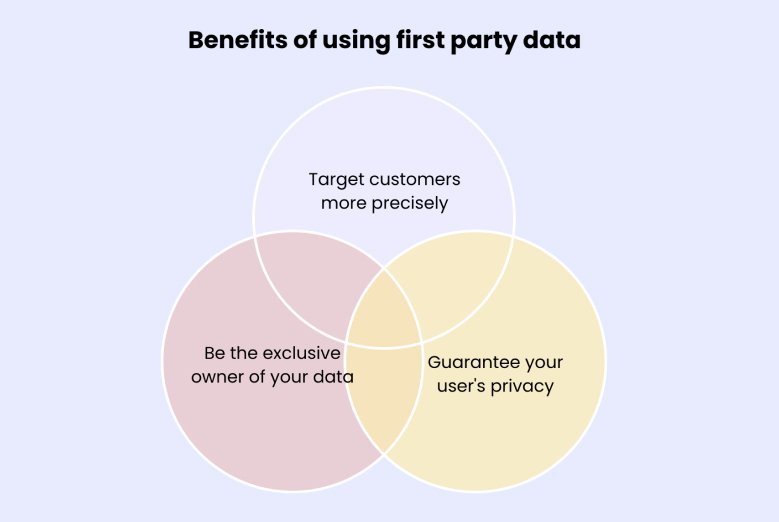
Parce qu'elles proviennent directement de la façon dont le public d'une marque interagit avec ses produits et services, les données de première partie sont très précises, fiables et précieuses. Elles peuvent relier les besoins, les habitudes et les motivations des clients à leur comportement réel. Par exemple, ils peuvent voir comment une campagne de marketing bien connue a entraîné une reconnaissance significative de la marque et une augmentation des revenus.
L'augmentation du trafic sur le site web peut résulter d'une campagne de courrier électronique réussie avec des titres d'appel adaptés. Les marques peuvent ainsi déterminer ce qui a fonctionné, ce qui n'a pas fonctionné et pourquoi. Elles peuvent ainsi prendre de meilleures décisions pour l'entreprise.
L'une des façons les plus courantes d'utiliser les données clients consiste à créer des audiences similaires dans le gestionnaire de publicités Facebook. Vous pouvez ainsi créer des publicités très ciblées avec des annonces numériques destinées aux segments personnalisés de votre marque. Il s'agit d'une approche programmatique qui consiste à utiliser des données de première partie pour créer des publicités et atteindre un large public de clients potentiels.
Soyez le propriétaire exclusif de vos données
Les entreprises qui possèdent des données de première main sont totalement propriétaires et gestionnaires des informations relatives à leurs clients. Elles peuvent collecter, organiser et utiliser les données de première main sans tenir compte des effets ou des contraintes externes.
Lorsqu'elles obtiennent des données d'autres sources, d'autres entreprises décident des informations à acquérir et de la manière de les proposer, ce qui peut en réduire l'efficacité.
Ils peuvent, par exemple, se concentrer sur l'acquisition de certaines catégories de clients ou de certains types de données qui n'ont rien à voir avec les objectifs d'une marque.
Les données de première partie ne font l'objet d'aucun point de vue différent susceptible d'influencer la manière dont les spécialistes du marketing les utilisent dans le cadre de leurs tactiques. Les marques n'ont pas non plus à se préoccuper du fait que d'autres entreprises aient accès aux mêmes données, ce qui leur confère un avantage stratégique.
Garantir la protection de la vie privée de vos utilisateurs
L'un des aspects les plus délicats des données de seconde et de tierce partie est leur origine incertaine. Les entreprises risquent ainsi d'enfreindre les règles de confidentialité des données.
Il peut être risqué d'obtenir des données d'autres entreprises, car les responsables du marketing n'ont aucune idée de la manière dont ces données ont été recueillies ou si elles l'ont été en connaissance de cause.
En revanche, les données de première partie sont conformes aux lois sur la protection des données telles que le règlement général sur la protection des données (RGPD) et la loi californienne sur la protection de la vie privée des consommateurs (CCPA). Les entreprises qui collectent et utilisent des données de première main adhèrent à des valeurs essentielles telles que l'ouverture, la confidentialité et la responsabilité.
Cela réduit considérablement les risques de se heurter à des problèmes juridiques et d'être soumis à des sanctions sévères. Les entreprises peuvent savoir en toute confiance d'où proviennent leurs informations, comment elles ont été recueillies et si elles peuvent être utilisées.
Les utilisateurs se sentent également à l'aise avec les informations qu'ils soumettent, les personnes auxquelles elles sont communiquées et la manière dont elles sont traitées.
5 façons de collecter des données de première main
Formulaires de demande d'accès au web
Inviter les utilisateurs à demander un devis ou à soumettre un formulaire de demande de service sur votre site web est la manière la plus élémentaire de collecter des données de première partie. L'inclusion de ces formulaires est une méthode simple pour développer une base de données de profils de clients parfaits. Le plus beau, c'est que cela ne prend que quelques secondes !
Ce type de collecte de données de première partie ne devrait pas vous prendre beaucoup de temps et de ressources. Il vous suffit d'une page d'atterrissage et d'un petit formulaire dans lequel vous recueillerez des informations de base telles que le nom et l'adresse électronique, ou seulement l'adresse électronique.
Vous pouvez proposer une réduction ou un autre avantage aux nouveaux utilisateurs pour les rendre plus attrayants.
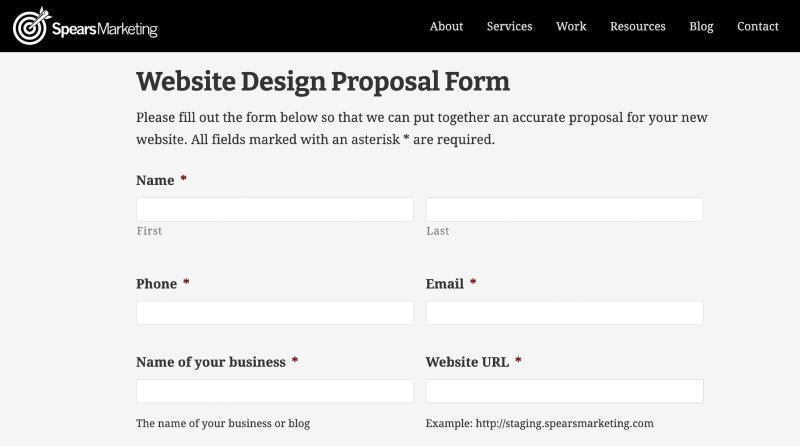
Bulletins d'information ou livres électroniques
Une autre façon de collecter des courriels est d'inviter les visiteurs à s'abonner à votre bulletin d'information ou à télécharger un livre électronique. Veillez à proposer un contenu de valeur qui ne finisse pas dans les spams. Par exemple, voyez la stratégie de Hubspot en matière de données de première partie. Ils utilisent des ebooks pour le profilage progressif, ce qui signifie qu'ils qualifient les personnes sur la base de leurs segments d'audience afin de pouvoir les traiter ultérieurement dans leurs pipelines de vente.
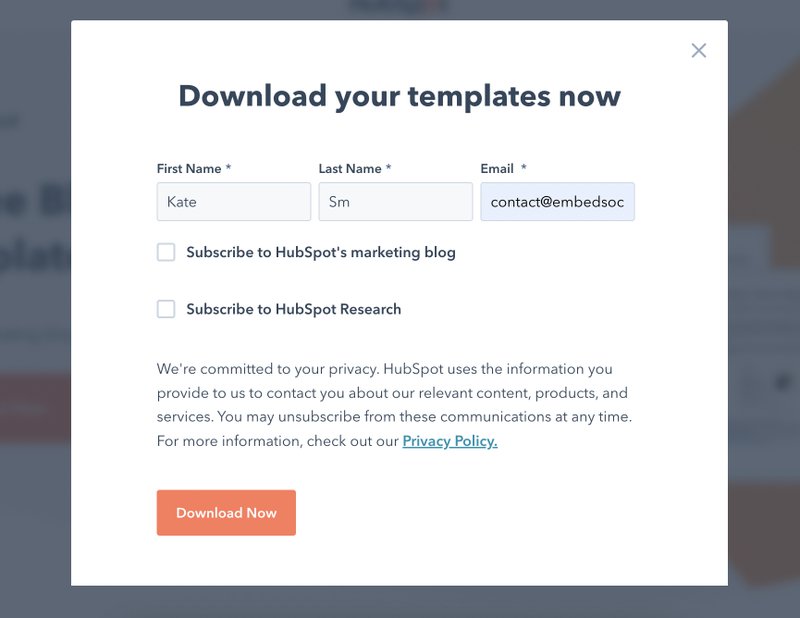
Connexion Google ou Facebook
Les utilisateurs aiment se connecter avec leur compte Google ou Facebook. Pour eux, cela élimine tout le processus d'enregistrement et rend les choses rapides et sans douleur.
Bien que ces services soient des tiers, si vous utilisez la documentation de leur API et que l'utilisateur donne des autorisations à son profil pour se connecter à votre service, il s'agit alors d'une source de données de première partie. Vous aurez accès à des données essentielles les concernant, telles que l'URL sociale, le nom, les centres d'intérêt et la géolocalisation.
En général, des applications plus sophistiquées comme EmbedFeed avec des intégrations d'API peuvent aider à collecter davantage de données sur les utilisateurs à partir de leurs comptes de médias sociaux. Mais ces données sont collectées avec une fenêtre d'autorisation de l'application, où l'utilisateur doit encore approuver la collecte de données de son profil social par l'application.
Outils d'analyse
Vous pouvez utiliser de nombreux outils d'analyse pour collecter des données de première main auprès de vos utilisateurs.
Le moyen le plus pratique est de mettre en place un suivi des événements et de suivre le parcours de l'utilisateur à travers les différentes interactions avec votre site web ou votre application.
Cela vous aidera à créer une image comportementale de vos utilisateurs. Vous pourrez savoir comment ils perçoivent votre produit, quels sont leurs intérêts, leurs préférences, etc. Vous découvrirez également certains défauts de l'interface de votre produit et aurez des idées pour l'améliorer.
Voici quelques outils que vous pouvez utiliser pour recueillir des informations sur le comportement de vos clients :
Enquêtes et formulaires auprès des clients
Si les clients aiment votre produit, ils seront heureux de répondre à quelques questions et de parler de leur expérience. En revanche, s'ils n'aiment pas votre produit, ils chercheront une occasion d'exprimer leur mécontentement.
Pour entrer en contact avec le consommateur et obtenir des données de première main, organisez une courte enquête ou un sondage en échange d'une récompense ou d'une réduction. Ils seront heureux de savoir que vous vous intéressez à leur opinion et que vous souhaitez améliorer votre produit pour eux.
EmbedForms est l'un des outils que vous pouvez utiliser pour recueillir les avis des clients. Parcourez nos outils de collecte d'avis modèles de widgets pour découvrir la meilleure façon de collecter des données de première main auprès de vos utilisateurs.
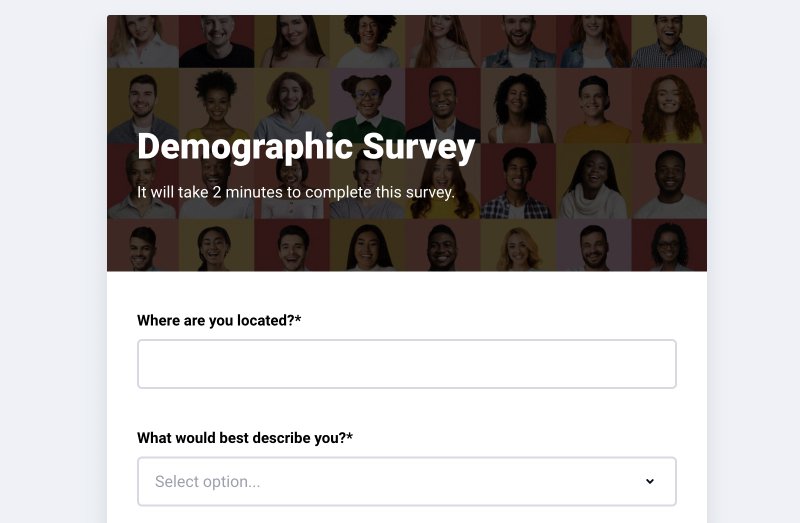
Exemples d'utilisation des données de première main
Ces exemples montrent comment et où les entreprises peuvent obtenir des données de première main. Utilisez-les pour planifier la manière dont vous commencerez à collecter des données de haute qualité auprès des clients qui ont accepté de les fournir.
Créer des expériences personnalisées
La personnalisation ne se limite pas à l'affichage du prénom d'un client sur un site web ou dans un courrier électronique. Les données de première partie contiennent les biens qu'un consommateur a déjà achetés chez vous, ce qui vous permet de présenter des articles connexes ou de mettre l'accent sur d'autres offres liées au comportement de ce client particulier.
Netflix vous propose ces suggestions en fonction de ce que vous avez regardé. Netflix recueille des données de première main pour vous proposer des divertissements en fonction de vos préférences. Par exemple, lorsque vous ouvrez la page d'accueil de Netflix, vous voyez une interface personnalisée.
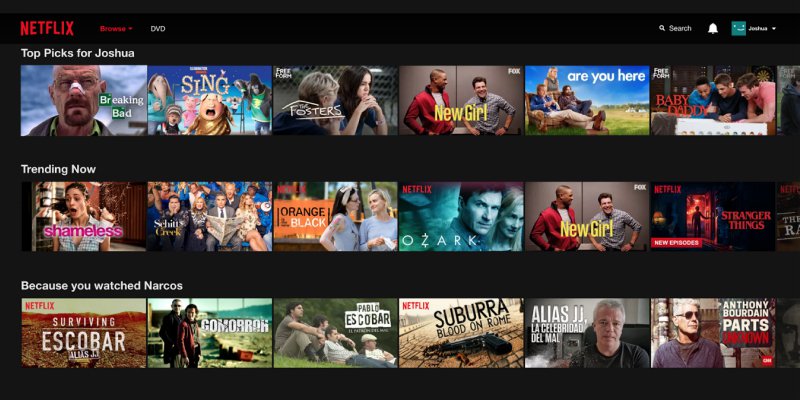
YouTube vous présente également du contenu de la même manière.
Ciblez plus précisément vos campagnes publicitaires
De nombreuses publicités s'appuient sur des données de tiers. Cependant, vous pouvez fournir des annonces plus précises sur vos plateformes publicitaires en utilisant des données de première main.
Le moyen le plus courant est le reciblage. Les annonces de reciblage vous permettent de montrer des publicités personnalisées aux personnes qui se trouvent déjà sur votre site web ou qui ont acheté certains produits.
Un autre exemple consiste à créer des audiences personnalisées sur Facebook ou d'autres plateformes avec les données démographiques ou comportementales que vous avez collectées auprès de vos utilisateurs.
Voici un exemple de campagne de reciblage de Samsung utilisant des publicités dynamiques pour cibler les personnes ayant déjà effectué une action sur le site web de la marque. Pour ce faire, ils doivent ajouter un pixel Facebook sur leur site web afin d'obtenir les données des visiteurs et créer des audiences personnalisées dans le gestionnaire Facebook lors de la création des publicités.

Prévoir le parcours du client
Les spécialistes du marketing peuvent retracer le parcours du client en combinant et en collectant des données de première main à partir d'une ressource unique d'identification du client, ce qui permet de découvrir les nombreuses étapes que les clients franchissent sur le chemin de la vente, ainsi que l'ordre dans lequel ils les franchissent.
Les spécialistes du marketing peuvent ainsi diffuser le bon message au meilleur moment possible, et mettre en place des tactiques visant à réengager les clients au cours de leur processus d'achat.
En outre, les données de première main peuvent être utilisées pour influencer les choix de canaux et les dépenses. Comprendre comment chaque étape de l'expérience client influence la conversion permet une analyse plus précise de l'attribution et une meilleure compréhension de la façon dont les fluctuations budgétaires affectent à la fois l'engagement en ligne et les ventes dans les magasins physiques.
L'avenir avec des données sans contrepartie
Les données de première partie sont celles que vous obtenez directement de vos clients,
Vous pouvez utiliser les données "zero-party" pour adapter le contenu, générer des recommandations de produits personnalisées et personnaliser l'expérience en fonction des intérêts exprimés par les utilisateurs.
Par exemple, vous pouvez demander à un client qui s'est inscrit à votre produit quel est son rôle dans l'entreprise. Disons que les réponses possibles sont : responsable marketing, assistant marketing ou stagiaire. Sur cette base, vous pouvez adapter le contenu que vous lui envoyez et lui présenter des recommandations spécifiques à son rôle dans l'entreprise.
Les données devenant de plus en plus sensibles, la collecte de données "zero-party" deviendra essentielle pour établir des relations significatives avec les clients à l'avenir. Mais pour cela, les marques doivent comprendre clairement ce qu'elles offrent à leurs clients afin qu'ils puissent partager leurs données. Seulement 56% des agents de commercialisation pensent que leur organisation offre un échange de valeur clair en échange du partage de leurs données par les clients. Une question que les 44% autres marques devront résoudre rapidement.
Principaux enseignements
À une époque où la concurrence est rude, il est indéniable que les données de haute qualité que les entreprises peuvent recueillir directement auprès de leurs clients sont essentielles pour comprendre les intentions d'achat.
Les règles relatives aux données et le comportement des clients évoluant, la validité et la fiabilité des données de première partie de votre marque sont plus importantes que jamais.
Les entreprises qui ne maximisent pas la valeur de leurs données de première main passent à côté de l'énorme potentiel qu'elles ont pour accroître l'engagement des clients et leur offrir une expérience exceptionnelle. Avoir une stratégie de données et investir dans une plateforme de gestion des données clients est quelque chose que vous devez envisager sérieusement.
N'oubliez pas qu'il est toujours plus coûteux d'attirer de nouveaux clients que de fidéliser les clients existants. Et pour comprendre le comportement, l'historique des achats et les préférences de vos clients actuels, vous avez besoin de données de haute qualité.
Vous l'avez déjà entre les mains ; il vous suffit de commencer à l'utiliser pour en tirer de précieuses informations sur la voie de la réussite.

